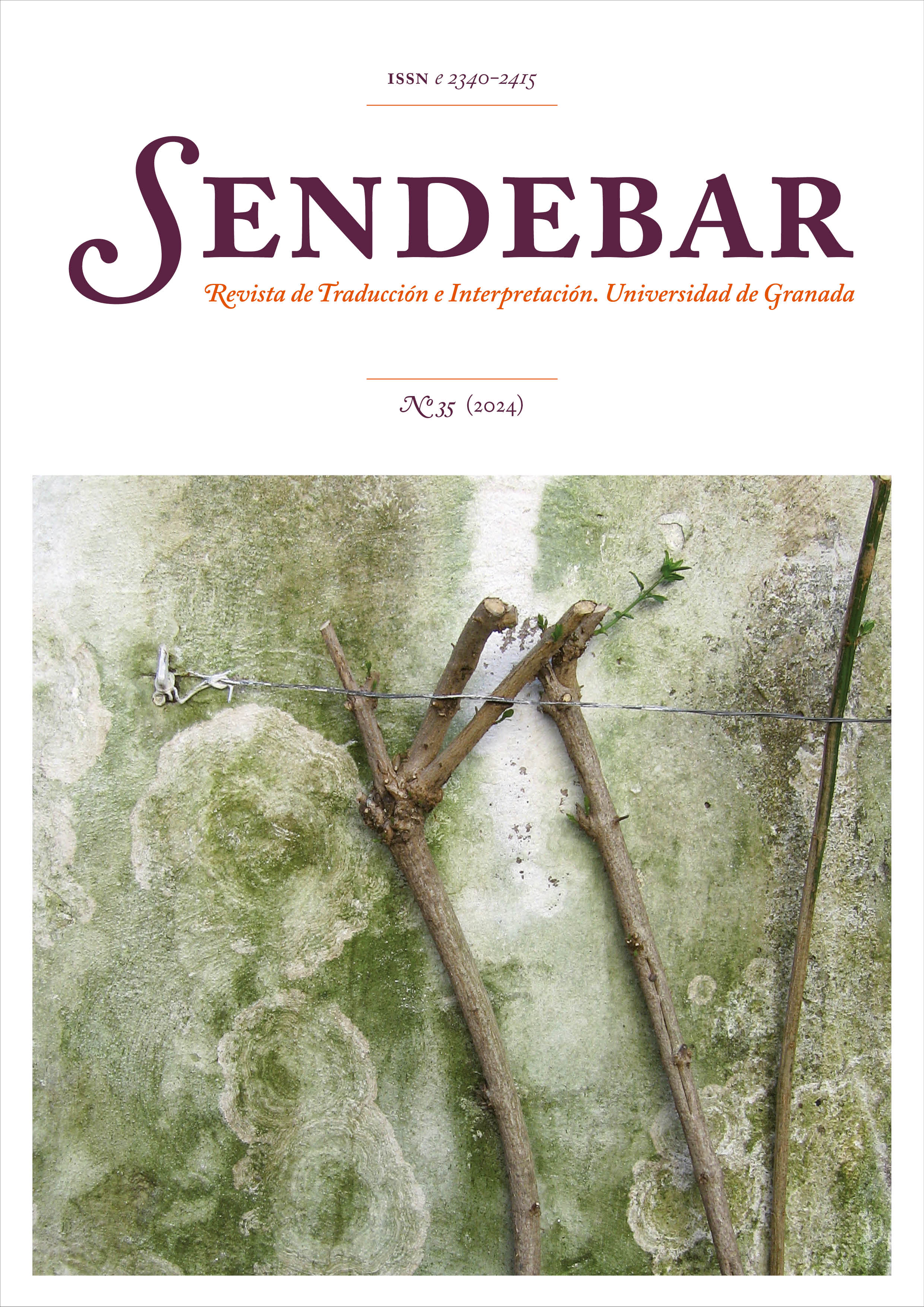Description of the Narrative Comprehension of a Film with Subtitles for the Deaf and Hard-of-Hearing (SDH)
DOI:
https://doi.org/10.30827/sendebar.v35.29996Keywords:
audiovisual translation, subtitling for the deaf and the hard-of-hearing, reception, accessibility, narrative comprehensionAbstract
This paper presents the results of a descriptive study with qualitative data whose objective was to describe the narrative comprehension of a film with subtitles for the Deaf and Hard-of-Hearing. A comprehension questionnaire was implemented to collect data, based on the narrative schema model proposed by Stein and Glenn (1979). Likewise, a retrospective survey and a demographic and reading habits survey were applied. Six people with different hearing loss participated in the study. Regarding the results, different levels of performance were observed in terms of narrative comprehension. From highest to lowest, the performance level of participants in the categories was: Scene, followed by execution, consequence and/or reaction, internal plan, internal response, and initial event. Likewise, it was observed that there are no difficulties ordering the sequence of episodes.
Downloads
References
Cambra, C., Leal, A. & Silvestre, N. (2010). How Deaf and Hearing Adolescents Comprehend a Televised Story. Deafness & Education International. 12(1), 34-51. https://doi.org/10.1179/146431510X12626982043606
Cuéllar, C. (2020). Unterti tel für Gehörlose vs. subtitulado para sordos: el reto de hacer visible lo inaudible. MonTI Monografias de Traducción e Interpretación. https://www.researchgate.net/publication/341178903_Untertitel_fur_Gehorlose_vs_subtitulado_para_sordos_el_reto_de_hacer_visible_lo_inaudible
Díaz, S., Mendoza, V. & Porras, C. (2011). Una guía para la elaboración de estudios de caso. Razón y Palabra, 16(75), 1-26. http://www.razonypalabra.org.mx/N/N75/varia_75/01_Diaz_V75.pdf
Di Giovanni, E., & Gambier, Y. (Ed.). (2018). Reception Studies and Audiovisual Translation. Amsterdam/ Philadelphia: Editorial John Benjamins B.V
Hernández, R., Fernández, C. & Baptista, P. (2014). Metodología de la Investigación. McGraw-Hill.
Hernández, R. & Mendoza C. (2018). Metodología de la investigación: Las Rutas Cuantitativa, Cualitativa y Mixta. https://books.google.es/books?hl=es&lr=&id=5A2QDwAAQBAJ&oi=fnd&pg=PP1&dq=investigacion+MIXTA&ots=TjXlYZ1pM2&sig=k-Ac6M8j7h33VfWEx_JvJC6TRk#v=onepage&q&f=false
Marchesi, A., & Paniagua, G. (2014). El recuerdo de cuentos e historias en los niños. Infancia y Aprendizaje. Journal for the Study of Education and Development, 6(22), 25-45. https://www.tandfonline.com/doi/abs/10.1080/02103702.1983.10821972
Marshall, N. (1983). Using Story Grammar to Assess Reading Comprehension. The Reading Teacher, 36(7),616-620. https://www.jstor.org/stable/20198293
Martínez, P. (2006). El método de estudio de caso: estrategia metodológica de la investigación científica. Pensamiento & gestión. (20),165-193. https://www.redalyc.org/pdf/646/64602005.pdf
Matamala, A. & Orero, P. (Eds.) (2010). Listening to Subtitles: Subtitles for the Deaf and Hard of Hearing. Peter Lang.
Miquel, M. (2017). The reception of subtitling for the deaf and hard of hearing: viewers’ hearing and communication profile & Subtitling speed of exposure. [Tesis Doctoral. Universidad Autónoma de Barcelona]. https://core.ac.uk/download/pdf/132091669.pdf
Organización Mundial de la Salud (OMS). (2011). Informe mundial sobre la discapacidad. https://www.minsalud.gov.co/sites/rid/Lists/BibliotecaDigital/RIDE/INEC/INTOR/informe-mundial-discapacidad-oms.pdf
Organización Panamericana de la Salud OPS. (s.f.). Discapacidad. https://www.paho.org/es/temas/discapacidad
Paris, A. & Paris, S. (2003). Assessing narrative comprehension in young children. Reading Research Quarterly, 38 (1), 36-76. https://deepblue.lib.umich.edu/bitstream/handle/2027.42/88014/RRQ.38.1.3.pdf?sequence=1
Reyes, C. (2003). Visión Panorámica de los estudios sobre narración. Revista de Humanidades: Tecnológico de Monterrey, (15), 95-119
Richart-Marset, M., & Calamita, F. (2020). El gran reto de la traducción y la accesibilidad audiovisual en los medios de comunicación, MonTI 12, 29-52. https://www.researchgate.net/publication/341259131
Romero-Fresco, P. (2018). Eye Tracking, Subtitling and Accessible Filmmaking. En T. Dwyer, C. Perkins, S. Redmond & J. Sita (Eds.), Seeing into Screens: Eye Tracking and the Moving Image (pp. 235-258). Bloomsbury. https://www.researchgate.net/publication/323178846_Eye_Tracking_Subtitling_and_Accessible_Filmmaking
Sabino, C. (2009). El Proceso de Investigación. Nueva edición actualizada. Editorial PANAPO.
Stein, N. & Glenn, C. (1979). An Analysis of Story Comprehension in Elementary School Children. Research Gate. 53-120. https://www.researchgate.net/publication/243501171_An_Analysis_of_Story_Comprehension_in_Elementary_School_Children
Stein, N. & Nezworski, T. (1978). The effects of organization and instructional set on story memory. https://scholar.google.com/citations?view_op=view_citation&hl=en&user=W2hTG7MAAAAJ&citation_for_view=W2hTG7MAAAAJ:UxriW0iASnsC
Strasser, K., Larraín, A., López de Lérida, S., & Lissi, M. R. (2010). La Comprensión Narrativa en Edad Preescolar: Un Instrumento para su Medición. Psykhe, 19(1), 75-87. https://www.redalyc.org/articulo.oa?id=96715365006
Tuominen, T. (2018). Multi-method Research. Reception in Context in Elena Di Giovanni and Yves Gambier. (Ed.), Reception Studies and Audiovisual Translation (pp.69-89). John Benjamins B.V.
Tsaousi, A. (2018). El disfrute de la experiencia audiovisual por personas sordas y con diversidad auditiva: la representación visual de los efectos sonoros. Anuario Electrónico De Estudios En Comunicación Social “Disertaciones”, 11(1), 110–126. https://doi.org/10.12804/revistas.urosario.edu.co/disertaciones/a.4982
Downloads
Published
How to Cite
Issue
Section
License
Copyright (c) 2024 Carmenza Ríos Cardona, Sandra Milena Rudas Bermúdez

This work is licensed under a Creative Commons Attribution-NonCommercial 4.0 International License.
Terminos de Licencia Sendebar.

















